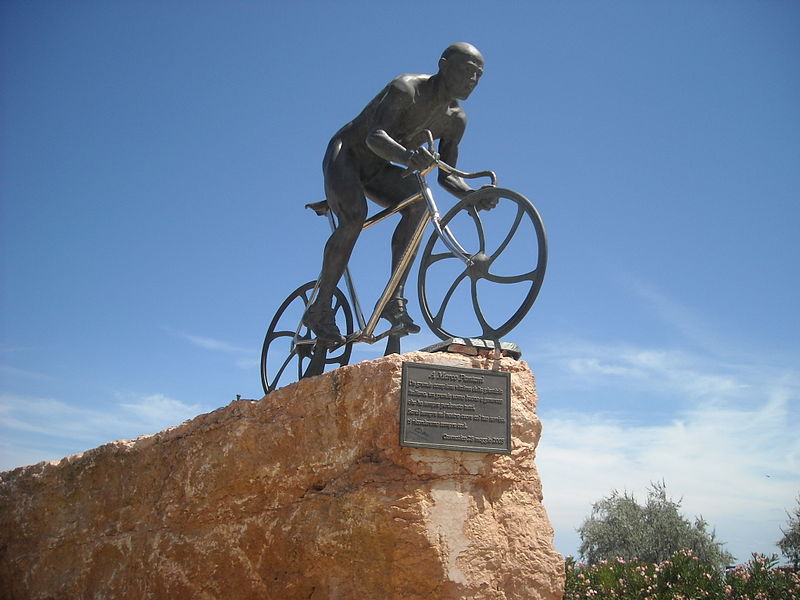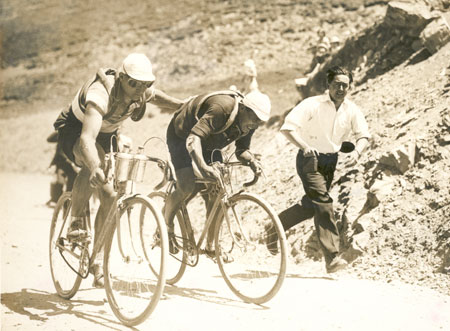|
1935 Giro D'Italia
The 1935 Giro d'Italia was the 23rd edition of the Giro d'Italia, organized and sponsored by the newspaper ''La Gazzetta dello Sport''. The race began on 18 May in Milan with a stage that stretched to Cremona, finishing back in Milan on 9 June after a stage and a total distance covered of . The race was won by the Italian rider Vasco Bergamaschi of the Maino team, with fellow Italians Giuseppe Martano and Giuseppe Olmo coming in second and third respectively. This Giro saw the last participation of Alfredo Binda and the first of Gino Bartali, then 20 years old, who won the mountains classification. Participants Of the 101 riders that began the Giro d'Italia on 18 May, 62 of them made it to the finish in Milan on 9 June. Riders were allowed to ride on their own or as a member of a team; 55 riders competed as part of a team, while the remaining 46 competed independently. There were eight teams that competed in the race: Bianchi, Dei, Fréjus, Gloria, Helyett, Legnano, and ... [...More Info...] [...Related Items...] OR: [Wikipedia] [Google] [Baidu] |
Vasco Bergamaschi
Vasco Bergamaschi (29 September 1909 – 24 September 1979) was an Italian professional road racing cyclist. Career Born in San Giacomo delle Segnate, Lombardy, Bergamaschi turned professional in 1930. The highlight of his career was his overall win in the 1935 Giro d'Italia, thanks to the collaboration of his teammate Learco Guerra. His other victories include a Giro del Veneto (1935), a Milano-Modena (1940), another stage in the 1939 Giro d'Italia, and a stage in the 1935 Tour de France. He later worked as manager for the Torpado team. Career achievements Major results ;1930 :Coppa del Re :Tour de Hongrie The Tour de Hongrie ( en, Tour of Hungary) is a professional road bicycle stage race organized in Hungary since 1925. History The inaugural Tour de Hongrie took place on 27 June 1925. The cyclists hit the road as early as four in the morning, an ... ;1935 :Giro del Veneto : Tour de France: ::Winner stage 13A : Giro d'Italia: :: Winner overall classification ::Winner ... [...More Info...] [...Related Items...] OR: [Wikipedia] [Google] [Baidu] |
Learco Guerra
Learco Guerra (14 October 1902 - 7 February 1963) was an Italian professional road racing cyclist. The highlight of his career was his overall win in the 1934 Giro d'Italia. He was born in San Nicolò Po, a ''frazione'' of Bagnolo San Vito in Lombardy, gained the nickname of "Human Locomotive" for his enduring quality in plain stages. After mediocre attempts to play football, Guerra became a professional cyclist in 1928, at 26. The following year he became Italian champion, racing as an independent or semi-professional. In 1930 he won his first Italian National Road Race Championships, the first of five straight wins. That same year he came second in the Tour de France after Italy's leader, Alfredo Binda, proved in poor form. The race was won by the Frenchman, André Leducq. In 1931 Guerra won four stages of the Giro d'Italia but not the final victory. In this Giro, he was the first rider who wore the pink jersey. The same year he won the world cycling championship. In 1933 G ... [...More Info...] [...Related Items...] OR: [Wikipedia] [Google] [Baidu] |
Cesenatico
Cesenatico ( rgn, Ziznàtic) is a port town with about 26,000 inhabitants on the Adriatic coast of Italy. It is located in the province of Forlì-Cesena in the region of Emilia-Romagna, about south of Ravenna. Cesenatico's port canal was surveyed and drawn by Leonardo da Vinci at the request of Cesare Borgia, as part of his plans to fortify the nearby town of Cesena. History Cesenatico was founded in 1302. It was considered part of the city of Cesena until it was incorporated at the beginning of the 18th century. Its port and canal were built in 1314, with the canal originally planned to reach Cesena, some inland. At the request of Cesare Borgia the canal was later surveyed by Leonardo da Vinci. It is often erroneously claimed that da Vinci designed the canal. In 1722 James Francis Edward Stuart (the 'Old Pretender' to the British throne) stayed in Cesenatico's Capuchin monastery. From 1860 to today The Republican vocation of Cesenatico is evident in the elections of the foll ... [...More Info...] [...Related Items...] OR: [Wikipedia] [Google] [Baidu] |
Rovigo
Rovigo (, ; egl, Ruig) is a city and ''comune'' in the Veneto region of Northeast Italy, the capital of the eponymous province. Geography Rovigo stands on the low ground known as Polesine, by rail southwest of Venice and south-southwest of Padua, and on the Adigetto Canal. The ''comune'' of Rovigo extends between the rivers Adige and Canal Bianco, west of the Adriatic Sea, except the ''frazione'' of Fenil del Turco that extends south of the Canal Bianco. Polesine is the name of the low ground between the lower courses of the rivers Adige and Po and the sea; the derivation of the name is much discussed, generally applied only to the province of Rovigo, but is sometimes extended to the near towns of Adria and Ferrara. History Rovigo (both ''Rodigium'' and ''Rhodigium'' in Latin script) appears to be first mentioned in a document from Ravenna dating April 24, 838; the origin of the name is uncertain. In 920 it was selected as his temporary residence by the bishop of ... [...More Info...] [...Related Items...] OR: [Wikipedia] [Google] [Baidu] |
Mantua
Mantua ( ; it, Mantova ; Lombard language, Lombard and la, Mantua) is a city and ''comune'' in Lombardy, Italy, and capital of the Province of Mantua, province of the same name. In 2016, Mantua was designated as the Italian Capital of Culture. In 2017, it was named as the European Capital of Gastronomy, included in the Eastern Lombardy District (together with the cities of Bergamo, Brescia, and Cremona). In 2008, Mantua's ''centro storico'' (old town) and Sabbioneta were declared by UNESCO to be a World Heritage Site. Mantua's historic power and influence under the Gonzaga family has made it one of the main artistic, culture, cultural, and especially musical hubs of Northern Italy and the country as a whole. Having one of the most splendid courts of Europe of the fifteenth, sixteenth, and early seventeenth centuries. Mantua is noted for its significant role in the history of opera; the city is also known for its architectural treasures and artifacts, elegant palaces, and the m ... [...More Info...] [...Related Items...] OR: [Wikipedia] [Google] [Baidu] |
René Vietto
René Vietto (17 February 1914, Le Cannet, Alpes-Maritimes – 14 October 1988, Orange, Vaucluse) was a French road racing cyclist. In the 1934 Tour de France, Vietto, a relative unknown, got wings on the mountains. This was not a surprise, because he had won the Grand Prix Wolber. He was prepared for the Alps and won easily on the steepest terrain. After he won the two major Alpine stages, journalists reported that this 'boy' could be the purest mountain climber that France knew. During the 1934 Tour, he was poised to be race leader after his team leader Antonin Magne crashed during stage 16. Vietto was unaware of Magne's situation; his advantage gave him the virtual race lead. A marshal on a motorcycle caught Vietto to inform him his captain was on the side of the road, with team-mate Lapébie ahead, and the other team-mates behind the yellow jersey. Vietto turned and rode back up the mountain into the descending riders (at the time, reversing course was legal, but is no l ... [...More Info...] [...Related Items...] OR: [Wikipedia] [Google] [Baidu] |
Jef Demuysere
Jef Demuysere (Wervik, 26 July 1907 – Antwerp, 30 April 1969) was a Belgian professional road bicycle racer. He won the Milan–San Remo in 1934, and finished on the podium of the Tour de France in 1929 and 1931, and of the Giro d'Italia in 1932 and 1933. Major results ;1926 :Paris-Arras ;1927 :Ronde van Vlaanderen for amateurs ;1929 :Paris-Longwy :Tour de France: ::Winner stage 10 ::3rd place overall classification ;1930 :Circuit du Morbihan :Tour de France: ::4th place overall classification ;1931 : Omloop der Vlaamse Gewesten :Tour de France: ::Winner stages 15 and 18 ::2nd place overall classification ;1932 : Belgian National Cyclo-cross Championships : Giro d'Italia: ::2nd place overall classification :Tour de France: ::8th place overall classification ;1933 : Giro d'Italia: ::2nd place overall classification ;1934 :Milan–San Remo ;1935 :Poperinge Trivia * In his native town Wervik Wervik (; french: Wervicq, ; vls, Wervik; la, Viroviacum) is a city and mu ... [...More Info...] [...Related Items...] OR: [Wikipedia] [Google] [Baidu] |
Maurice Archambaud
Maurice Archambaud (30 August 1908 in Paris – 3 December 1955 in Le Raincy) was a French professional cyclist from 1932 to 1944. His short stature earned him the nickname of ''le nabot'', or "the dwarf", but his colossal thighs made him an exceptional rider. He won Paris-Soissons and Paris-Verneuil as an amateur in 1931 and turned professional the following year for Alcyon, one of the top teams in France. He won the inaugural Grand Prix des Nations in his first season. He set the world hour record at 45.767 km at the Vigorelli velodrome in Milan on 3 November 1937. He beat the Dutchman, Frans Slaats' record of 45.485 km, set on 29 September 1937. The record stood for five years before being beaten by Fausto Coppi. Archambaud rode for France in the Tour de France between the wars. His sudden changes of form and frequent falls meant that he never won the race, but he did win ten stages and wear the yellow jersey. He won a shorter stage race, Paris–Nice, in 1936 an ... [...More Info...] [...Related Items...] OR: [Wikipedia] [Google] [Baidu] |
André Leducq
André Leducq (; 27 February 1904 – 18 June 1980) was a French cyclist who won the 1930 and 1932 Tours de France. He also won a gold medal at the 1924 Summer Olympics in the team road race event and the 1928 Paris–Roubaix. Career Leducq was born at Saint-Ouen. He was world champion in 1924 as an amateur before turning professional in 1927. The following year he won Paris–Roubaix and was second in the Tour de France, becoming popular for his humour. His other victories included two Tours de France (he won 25 stages in nine rides) and the 1931 Paris–Tours. He has the fourth-highest number of stage wins in the Tour de France (behind Eddy Merckx, Bernard Hinault, and Mark Cavendish). After his retirement, he founded a professional cycling team that raced in the 1950s. Career achievements Major results ;1927 : Tour de France :: 4th overall ::Stage 6, 23 and 24 wins ;1928 :Tour de France :: 2nd overall ::Stage 2, 10, 11 and 16 wins : Paris–Roubaix ;1929 :Tour d ... [...More Info...] [...Related Items...] OR: [Wikipedia] [Google] [Baidu] |
Tour De France
The Tour de France () is an annual men's multiple-stage bicycle race primarily held in France, while also occasionally passing through nearby countries. Like the other Grand Tours (the Giro d'Italia and the Vuelta a España), it consists of 21 stages, each a day long, over the course of 23 days, coinciding with the Bastille Day holiday. It is the oldest of the Grand Tours and generally considered the most prestigious. The race was first organized in 1903 to increase sales for the newspaper '' L'Auto'' and is currently run by the Amaury Sport Organisation. The race has been held annually since its first edition in 1903 except when it was stopped for the two World Wars. As the Tour gained prominence and popularity, the race was lengthened and its reach began to extend around the globe. Participation expanded from a primarily French field as more riders from all over the world began to participate in the race each year. The Tour is a UCI World Tour event, which means th ... [...More Info...] [...Related Items...] OR: [Wikipedia] [Google] [Baidu] |



